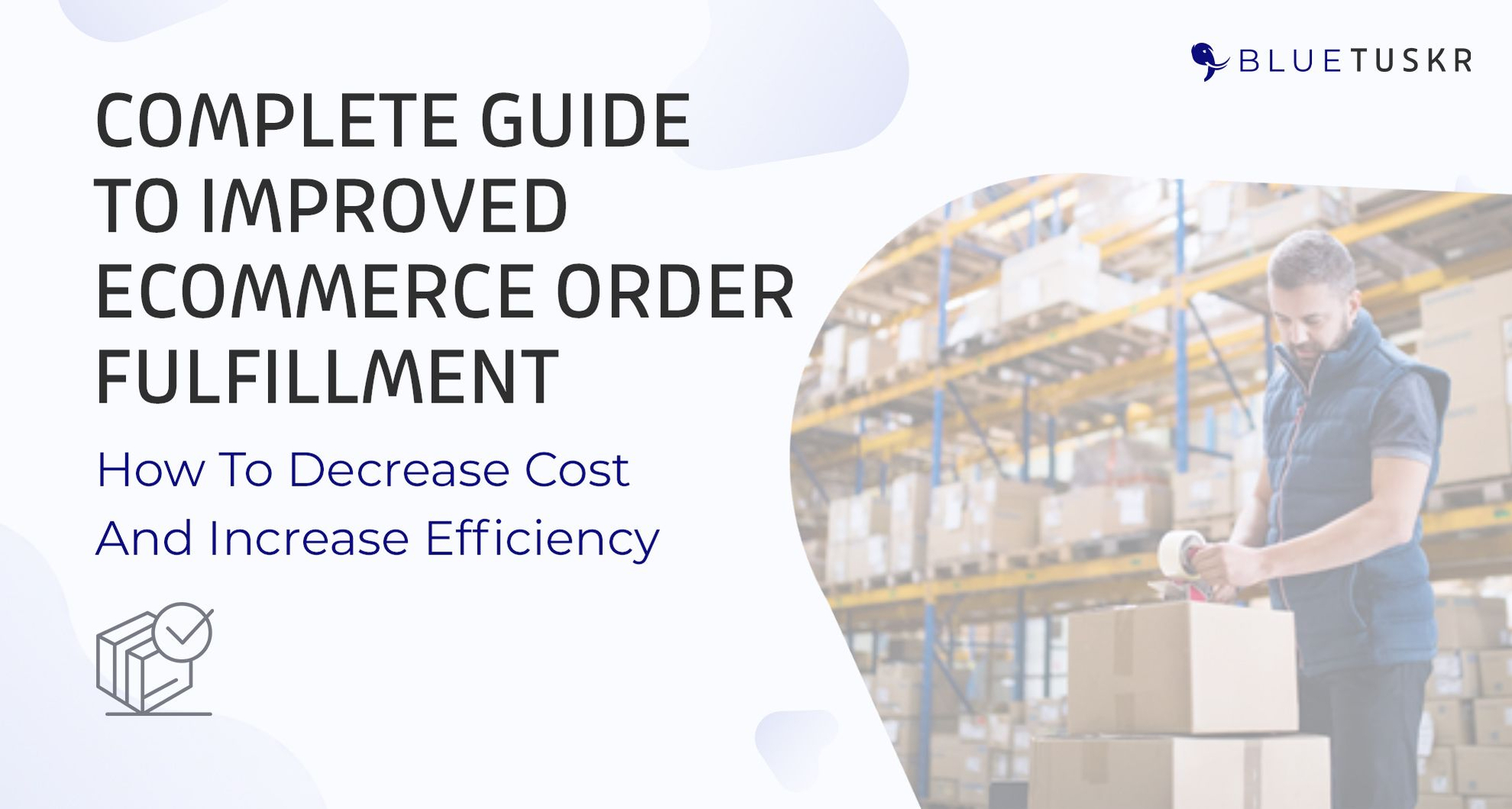
Complete Guide to Improved eCommerce Order Fulfillment: How to decrease costs and increase efficiency - Updated 2023
Most retailers will agree that order fulfillment and shipping are often time-consuming, and inconvenient, but are a critical part of day-to-day operations. Today’s eCommerce consumers have high expectations for receiving accurate orders in the most expedited manner possible - and at the lowest cost. Whether you are seeking to outsource your fulfillment or maintain your orders in-house for your startup, there are many ways that you can improve your overall operations.

Reduce Waste
Overproduction
Refers to producing more than can be used or sold. Overproduction wastes money, time, and space. Overproduction in shipping warehouses can be seen in instances when more boxes are made than a project needs or when shelves are built but never fully utilized.
Transporting
Adds no value to the product - it costs money and can sometimes damage or cause wear to the product. Identify the suitable amount of times that a product should be “touched” by employees throughout its lifecycle in the warehouse. To find an appropriate number, look at the transportation path of each product from arrival to shipping.
Old inventory
Can take up valuable warehouse space. Any inventory that has remained unsold for six months is probably costing you money and should be put on sales or donated to charity. The same can be said for items that are no longer used in the warehouse such as packaging, equipment, and tools.
Organizing
Is a highly effective tool for saving time and money. Everything from pens to pallet jacks should have its own place in the warehouse. Consider how much time is wasted in your warehouse by employees walking around looking for these everyday tools.
Waiting
Causes processes in the manufacturing world to be time-wasting and ineffective. This can be seen in shipping warehouses when pickers are waiting for equipment that is being used by another person, waiting for more orders to print, or waiting for a product to be retrieved from a higher location. Evaluating waiting within warehouses to help ensure the best efforts are being made to reduce the wasted time.
Unnecessary Motion
Occurs when resources are being wasted by workers having to reach, bend or walk in order to complete the job.
Moving SKUs
Closer together can have a positive impact on reducing warehouse “waste.” If you have an upcoming sale for five SKUs that are all located in different areas of the warehouse, evaluating whether moving the items close together will greatly reduce picking time and order processing.
Separating SKUs
Into single SKU cartons can improve accuracy and reduce the number of steps required to properly receive inventory.
Excessive Inventory
Is a major contributor to waste in the retail world Having excessive entropy on hand wastes resources by occupying valuable floor space and tying up money.
Defect
Waste time and cost money. Waste can be greatly reduced by identifying why defects occur. Defects can be caused by a variety of factors including insufficient packaging and faulty materials used during production.

Standardize Systems
Standardizing
Acknowledges the need for employees to adhere to a standard or set of rules for each task, job, function, or position they perform. A warehouse runs most efficiently when employees are held accountable to standards they have been trained and certified to perform.
Inventory Velocity
Refers to the amount of time that elapses between the receipt of the inputs and the delivery of the final product. It is important to store products by velocity, which means that you are organizing your production in such a way that the fastest moving items are in a location that shortens the pick-up time length.
Sorting and Batching
Your orders are a common method to reduce pick time and increase productivity. You must select a method that best suits your warehouse. The most common way of batching is by SKU. To better utilize your warehouse space and employees, orders should be divided by zones. Zones can assist in picking orders.
Wave Picking
Is a great method for increasing efficiency in your warehouse. It is a way of organizing high-volume items so they can be shipped out as soon as possible. This procedure allows the pickers to pick the product in “waves” that relate to the current sale. Any unsold product remaining in the “wave” queue for a chosen amount of time, would be moved to a permanent pick location.
Pairing
Is another method for increasing picker efficiency. Often when a certain product sells, so will another. For example, when a camera sells, a memory card will also often be purchased. Locating these products next to each other can greatly reduce pick time. Products can also be grouped together this way in combinations of more than two.
Kit or Assemble
Products before picking to save time and increase order accuracy. The items are often sold individually as well, so be sure to not kit too many in order to avoid disassembling.
Organizing Inventory
Effectively can contribute to smooth operations. At the very least, you should make sure that your entire procure line can be identified with a label. This can include a barcode, SKU, or UPC. It is preferable for products to already be individually labeled once they arrive from the manufacturer. Once properly labeled, inventory should be separated by product category and velocity. High-velocity items should be the easiest to access.
Calculating Warehouse Overhead
By dividing the total expenses for rent, utilities, repairs and maintenance, and property taxes by the percentage of the building associated with processing customer orders.
Product Identification
Keep it simple. SKUs that are too long or too complicated to identify can create confusion in the warehouse. An entrepreneur or small team who knows their products well may be able to easily identify products by complex SKUs. However, warehouse staff working with hundreds of SKUs a day may be slowed down by dealing with a complicated naming system or irregular SKU.
Product Location
For retailers who have small, in-house order fulfillment and shipping operations, it is likely that avoiding locating a product based on its storage location is possible. This is due to the fact that they are handling the product daily and know exactly where it is, if it has been moved, etc. However, implementing pricing by location can be very useful if a company is planning on moving to a warehouse or outsourcing.
Product Quantity
Knowing how much product quantity to keep in stock can be a challenge. The goal is to have a constant balance of lean inventory and satisfying the demands of your customers. There are many factors that can help in deciding the right inventory levels for your business. A good approach to product quantity is to remember that inventory should be turned at least four times per year. To implement this, cartons should be labeled with a manufacturer's date, if they are not already. This way products can be easily identified by how long they have remained unsold in storage.
Product Selection
When retailers are first starting our, product selection isn’t much of an issue. As a company grows, however, the number of SKUs can quickly grow with it. Too many product choices can result in a lot of inventory sitting around, thus tying up money. It is important to manage and determine the optimal number of products and SKUs for your business. Discovering the optimal number of products and SKUs easily will help to avoid unnecessary costs in the future.
Protecting Shipments
Generally, you want your fulfillment staff to pack shipments in the smallest box possible to protect their contents. For fragile items, the common rule of thumb is two inches of protection on all sides of the item. Taking the time to train your employees on proper methods to pack products is beneficial to reducing damages.
Product Mix
Evaluate your product mix and examine how many customers buy products and the promotions you run. If you give away a free gift with purchase, be sure that the free fit doesn’t cause shipping increases.

Returns
Return Policies
Have the potential to positively impact your company. Although they may be intimidating at first, flexible returns policies have been proven to increase sales and trust. Alternatively, inflexible return policies have shown to decrease sales. Be sure your policy is clear and easy to find on your website.
Handling and Processing Returns
Can be a headache. Outsourcing can save you a great deal of time and money. You can instruct the shipping warehouse that handles your returns as to how you like the returns processed.
Automated Returns Software
Can be integrated into your eCommerce site, allowing customers to easily file a claim and print a return label. This eliminated the need for a member of your team to process the request. You should also consider “pay on use” shipping labels so you only pay for necessary return labels.
Optimize Your Return Rates
Be sure product descriptions on your website are as accurate as possible - this way customers have a clear understanding of the product they are ordering, thereby reducing the number of orders returned due to a misrepresented product. Providing customer support with a designated number of discounts, gift cards, etc. to give customers who are unhappy with purchases is also a good way to reduce the number of your returns.

Customer Satisfaction
Order Accuracy
Is a simple yet powerful way to keep your customers happy. No customer is happy to receive a shipment only to realize their order is wrong. Guaranteeing order accuracy to your customers can build trust and satisfaction.
Fast Delivery
Offer your customers the option to select express delivery. If a customer is in a time crunch, they will be happy to know they can still receive their order on time, even if it means they pay a higher rate.
Order Tracking
Allows for transparency with your customers. It also allows them to track their order status, which can be helpful for those who need their products by a certain date. Providing customers with a tracking code to track orders reduces the number of phone calls and emails from customers inquiring about the location or status of their shipment.
Low-Cost Shipping.
Keeping shipping costs to a minimum helps prevent customers from shopping with a competitor who may offer the same product with free shipping.

Deciding on Outsourcing
When fulfilling orders doesn’t leave time in the day to work on important aspects of your growing business, costs to fulfill and ship orders are through the roof, customers are unhappy due to high shipping costs or shipment errors, or you are no longer able to scale - it may be time to outsourced fulfillment with a dedicated and experienced fulfillment service provider who can help eliminate the headaches and high costs for your eCommerce order fulfillment.
Here are factors you should consider when choosing between a 3PL or a warehouse.
Time
Is your most important commodity. How much is your time worth? Decide what the best use of your time is and focus on that. Understanding which responsibilities to delegate and when to do so is critical. What’s the return on investment of your time not to fulfill orders? While the best time to outsource fulfillment is different for every business, we’ve found it typically falls between 400 to 1000 orders per month.
Opportunity Cost
Is one of the most overlooked factors that eventually lead to cash flow issues. For example: is investing in a larger warehouse, equipment, or software the best use of your money? What happens when your business outgrows its current locations. How could you better invest that money into your business? All important questions to consider.
Scalability
Is critical for the eCommerce entrepreneur. Pay for what you need, when you need it. Your business will cycle up and down and may have seasonality considerations. Many eCommerce businesses move too many times early in their business cycle and do so at a significant cost in an effort to scale with the sudden growth that often comes with today’s new businesses.
Transit Times
Are crucial in meeting today’s customer expectations. Fast shipping is a leading factor in customer satisfaction, leading to reduced returns and helping ensure repeat customers. Putting your product in multiple locations to increase the speed of delivery, allows you to meet customer expectations and remain competitive.
Shipping Costs
Are able to be reduced in multiple ways. The first method is through the “pooling” of buying power from a 3PL to leverage discount rates. The second method, depending on the weight of the product, permits further savings to be achieved by reducing the number of “zones” the package must travel through, by using multiple locations.
Fixed Costs
Can be leading a contributor to cash flow woes for an eCommerce business. Buying a warehouse, or signing a lease, is one of the largest fixed cost commitments to consider. In addition, the utilization of space is rarely exact and therefore leads to underutilization or overcrowding. Warehouse space means additional utility costs that have both a fixed and variable cost based on usage and size.
Warehouse Management Software
Is one of the largest upfront costs to consider. It can be purchased or leased and some models offer tiered pricing by volume. In any case, understanding which is the right software and accounting for training and implementation costs need to be thought through. It’s also important to know the cost of ongoing maintenance of the software.
Transportation Management Software
Is another cost and the additional piece that requires serious consideration and needs to be managed. Typically, you’re paying a fixed fee for each shipment. Analysis of shipping rates, and working with carriers, are ongoing requirements. Many TMS companies include pre-negotiated shipping rates that potentially offer an opportunity to lower your shipping fees.
Customer Relations
Is an area that we believe you should “own.” We recommend delaying outsourcing this component of the business unless it doesn’t provide a competitive advantage. For many retailers, building relationships with customers and owning the relationship is a key differentiator. This is even more significant if that product you’re selling is unique and has a brand proposition. If you are reselling a product where volume has a greater value than building a brand, then you can certainly consider the option of outsourcing this component.
Freight
Costs are typically ignored or delegated to vendors, especially in the early stages of an eCommerce company. Most companies accept the markup provided by the manufacturer or vendor and don’t understand the full net contribution to the costs of the product. Many manufacturers also bury the cost in the purchase prices as an “all-in-” price to buy the product and therefore make it more difficult to differentiate.
Efficient shipping and order fulfillment is the key to continuing to grow your business. These small improvements will help you maximize your shipping and order fulfillment processes.
Are you interested in being a guest on the BlueTuskr E-commerce Blog? Click here for more information.
Connect With Us
Recent Post

.png)







Tell us what you think!